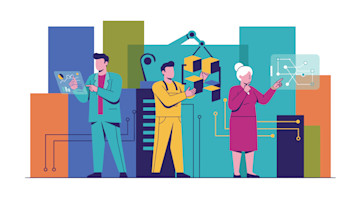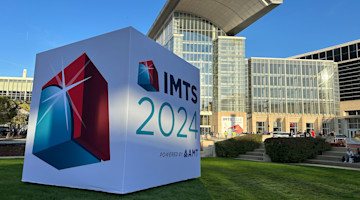Simultaneously staged international shows in America and Europe, IMTS in Chicago and AMB in Stuttgart, have long been highlights for the manufacturing technology world. Ultimately, AMB is a considerably smaller event than IMTS, but it has become the main European show for its concentration on a wide range of metalworking. Both events are a testimony of the undying strength of the machine tool industries. Let’s look at the state of the main European users of this technology as will be discussed during the IMTS International Breakfast.
A natural top recipient of manufacturing technology is automotive. Stuttgart, the capital of southwest Germany’s Baden-Württemberg state, is known as an automotive hub and home to the headquarters and museums of Mercedes-Benz and Porsche. It competes with BMW’s Muenchen in Bavaria and Volkwagen’s Wolfsburg in Lower Saxony. Automotive is a key industry for Germany, making it No. 1 in Europe. However, with Spain as No. 2, France No. 3, and Czechia No. 4, automotive is big across all of Europe. Only Luxembourg, Bulgaria, Cyprus, Denmark, Ireland, Greece, Malta, and the Baltic countries are not involved in automotive – neither in vehicle production nor components. The total revenue of the sector for the European Union (EU) alone for 2019 was nearly $1.2 trillion, the largest in European manufacturing.
It is less than that today, and its future needs to be redefined. In 2019 over 14 million motor vehicles were registered in total in free Europe (the EU, the four EFTA countries, and the U.K.). In 2021, that number fell to 9.9 million. The estimate for 2022 is 11 million. Unlike other industries where the pandemic and severe energy restraints were the main culprits for falling numbers, Europe’s automotive industry also faces a new structural problem. A large part of the downturn was caused by the trend toward electromobility, which is leading to a real shake-up of the market as the EV share of new car sales increases. Norway’s EV market share is already an astonishing 74%; EV sales in Iceland, Sweden, the Netherlands, Finland, Denmark, Switzerland, Portugal, and Germany account for “only” 13.5% of automotive sales.
In 2016, 4.2% of the total number of cars produced in Europe were cars with alternative propulsion (hybrid, electric car, alternative fuels); but the electric component of the vehicle mix has accelerated. In 2019 fully electric cars in the EU accounted for 1.9% of the total; in 2021, that rose to one in every 11 cars sold, and the total share of both fully electric and plug-in hybrid vehicles rose to 18%. In 2022 it could rise to more than 30%.
Many car manufacturers have been seriously affected and forced into product redefinition, especially smaller companies involved in producing components and parts. They account for nearly one-third of the sector, and many of them will have to retool for a new product or may not be needed.
The second largest user of machine tools is the aerospace and defense sector. It had a record revenue of $261 billion in 2019, and nearly half of that came from civil aeronautics. The 2020 fall was significant – dropping to $230 billion – and came as the result of a heavy reduction of over 25% in the civil and space sectors despite a slight increase in defense. The estimated figure for 2022 is already $245 billion, and a CAGR of 2.4% to 2027 has been projected.
There is rising demand for commercial and military aircraft, along with a substantial increase in defense spending. This has contributed to the recovery of the aerospace and defense industry in Europe. The recovery is bolstered by indigenous R&D, digital thread and smart factory processes, and the need to decarbonize. The development of advanced air mobility, demand for advanced military capabilities, the growth of the space market, and the growing aftermarket make this sector very promising. France, the U.K., Germany, Italy, Spain, Poland, and Sweden are the main markets.
Sourcing renewable energy has expanded in recent years in Europe, and it can offer some sales prospects for manufacturing, especially through additive technology. The renewable energy market in Europe is estimated at roughly $200 billion, but it will grow further. The current CAGR appears to be 6%- 8.5%. So far, it has supported over 22% of gross energy consumption of the EU in 2020 with a target of 30% by 2030. Renewable sources have already ensured 37% of the EU electricity, 23.1% of heating and cooling, and 10.2% of transport. The real challenge is industrial use.
Over 75% of energy from renewable sources have been generated mostly by wind, and some by water, although solar technology has recently been developing faster. This has resulted in the creation of large solar farms on land and water, many for industrial use only. The spread of sourcing differs from north to south in Europe, with Germany, France, the Netherlands, the U.K., and Scandinavia being strong in wind power, and Italy, France, the U.K., Switzerland, Spain, Greece, and Slovenia being strong in solar installations.
The European mold and dies market is not particularly large and had an understandable slump in 2020. Now it has returned to its pre-pandemic levels at about $13 billion per year. This recovery indicates potential business for specialized machine tools, allowing suppliers of such to target more than 7,000 factories and shops across Europe, with prevailing SMEs among them. Germany, Italy, Portugal, Spain, Czechia, Poland, Austria, Switzerland, and Slovenia are among leading countries.
Finally, while not an industrial newcomer, the European segment of medical devices has been undergoing rapid development. It has recently seen revenue growth of 6.3% annually and estimates nearly 6% growth for 2022-2027. Of the sector’s 2022-projected revenue, $132 billion, some $70 billion worth of production would involve the application of manufacturing technology. The largest concentration of producers is in Germany, followed by the U.K., Italy, Switzerland, Spain, and France.
The demand for manufacturing technology of the above and other manufacturing sectors of Europe cannot be fully satisfied by the European machine tool industry, wonderful as it is. For the main machine tool manufacturing countries (the members of the European Machine Tool Association, CECIMO), the record consumption of machine tools was recorded in 2018 at just under $19 billion. After the slump in 2020, 2022 consumption is expected to substantially exceed $18 billion. Encouragingly for non-European manufacturers, the same countries in 2018 that imported machine tools to the value of $12.5 billion imported machine tools to the value of over $10 billion in 2021 and are projected to import more again in 2022.
The industry is on the road to full recovery, showing resilience and good capacity utilization, but the market is open. There are projections that the entire European machine tool market (with Central but without Eastern Europe) should cross $40 billion by the end of 2026 – a long way from $22 billion in 2021, and an attractive sales target for U.S. manufacturers, who so far account for a mere $1 billion of the market.






